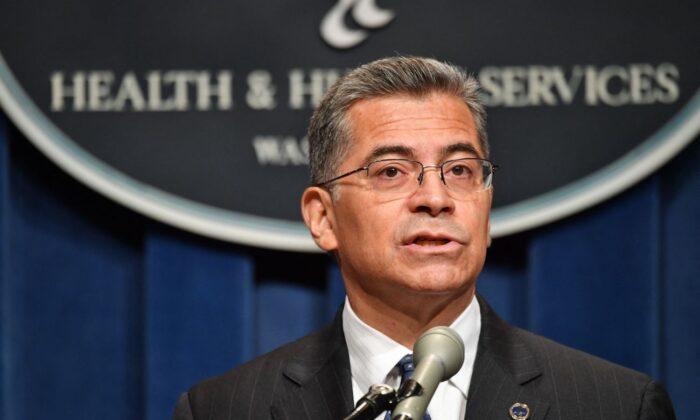The Biden administration has ordered 30 states to pause disenrollments from their Medicaid and Children’s Health Insurance Program (CHIP) programs and reinstate coverage for nearly 500,000 people after a computer glitch kicked them off.
During the COVID-19 pandemic, terminations of Medicaid coverage were paused until March 31. But now, state Medicaid agencies have resumed the standard annual redeterminations that were a staple of pre-pandemic times.
“I am deeply concerned about high rates of procedural terminations due to ‘red tape’ and other paperwork issues,” Health and Human Services Secretary Xavier Becerra wrote in a letter on July 28 to all governors, encouraging them to take steps to keep people on the rolls.
And now, some half a million people have had their coverage restored after officials found that they were removed from the Medicaid rolls due to a technical glitch.
“By making sure this systems glitch is fixed in states across the country, we will help stop more families and children from becoming disenrolled simply because of red tape,” Chiquita Brooks-LaSure, CMS administrator, said at a press briefing.
Medicaid, the health insurance program designed to provide coverage for lower-income individuals, is primarily administered by individual states, although the program receives significant financial support from the federal government.
More Details
At the end of August, CMS sent a letter (pdf) to all 50 states, the District of Columbia, Puerto Rico, and the U.S. Virgin Islands, requesting that they check to determine if they had problems with their eligibility systems that could cause people to be disenrolled from Medicaid and CHIP despite being eligible.“CMS has learned of additional systems and operational issues affecting multiple states, which may be resulting in eligible individuals being improperly disenrolled,” the Aug. 30 letter states. “These actions violate federal renewal requirements and must be addressed immediately.”
At the time, the agency found that some state computer systems were flagging entire households for further information and dropping all family members if no one replied instead of reviewing each person individually and automatically renewing children who were still eligible.
CMS’s latest action ordered states that were found to be in violation to halt procedural terminations until they fix their systems.
“Thanks to swift action by HHS, nearly half a million individuals, including children, will have their coverage reinstated, and many more will be protected going forward,” Mr. Becerra said in a Sept. 21 statement.
“We will continue to work with states for as long as needed to help prevent anyone eligible for Medicaid or CHIP coverage from being disenrolled,” he added.
Some state Medicaid directors said Thursday that they were unaware they had been doing things incorrectly.
“It was never clear that this was against the rule or against the regulation, because if it was, we would have been doing it differently a long time ago,” Cindy Beane, commissioner of the West Virginia Bureau for Medical Services and president of the National Association of Medicaid Directors, told The Associated Press.
‘Red Tape’
Recent data from the federal Centers for Medicare and Medicaid Services, which is reported with a lag, shows that in nearly two dozen states that began a post-pandemic review of their Medicaid rolls in April, health coverage was terminated for around 2.2 million people.Of these, around 79 percent in April and 77 percent in May were for “procedural reasons,” meaning they did not return the renewal form that they received in the mail or the state was unable to reach such individuals.
A decline in Medicaid coverage was widely expected because states were prohibited from ending people’s Medicaid coverage during the pandemic when enrollment swelled. Between February 2020 and February 2023, Medicaid enrollment jumped from 71 million to 93 million people.
But the ban on disenrollment ended on March 31, and states have been returning to regular operations, renewing coverage for eligible individuals and terminating it for those who no longer qualify.
As states unwind the continuous enrollment provision, KF estimated that 15-18 million in total could lose their Medicaid coverage over the coming year.
Since April, health officials have repeatedly raised concerns about the large number of Medicaid dropoffs.
He encouraged the governors to use information from other federal programs, such as food stamps, to automatically confirm people’s eligibility for Medicaid, averting the need to mail and return documents.
Under federal rules, most people have 90 days from the day they lost their Medicaid coverage to submit any missing information and potentially have their coverage reinstated.
Some states have adopted policies that are more likely to promote continued coverage among eligible enrollees, including automating their eligibility systems in order to process renewals more easily and accurately.
Nine states meet eight or more out of nine metrics for promoting continuity of coverage: Colorado, Illinois, Indiana, Massachusetts, Michigan, New Mexico, North Carolina, Virginia, and Washington.
Most states fall somewhere in the middle, while six states meet four or fewer of the measures: Arkansas, Nebraska, South Dakota, Missouri, Oklahoma, and Wyoming.







